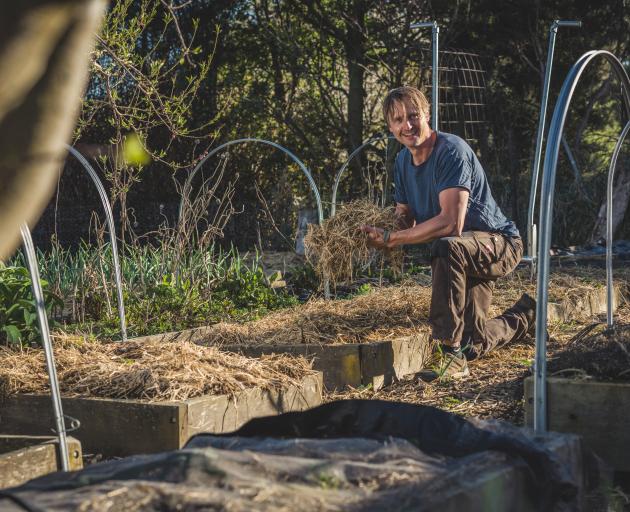
There's a big difference between dirt and soil, and it's important , Ben Elms, aka Dr Compost.
Because we tend to focus on growing plants above the ground, we often underestimate the importance of the earth under our feet. If you're starting out on a fresh piece of dirt, it's worth digging a little to find out what kind of soil you have.
Have a walk around your neighbourhood and take a nosy at your neighbours' back yards. See who the keen gardeners are, knock on their door and ask some questions about what you're dealing with. I guarantee you will get an enthusiastic reception; gardeners love sharing ideas about what's worked and what hasn't.
Failing that, go online or get along to a local gardening club. It's unlikely you've won the lottery with a beautiful, crumbly, loamy soil brimming with organic matter and life. But, hey, we have to have something to aim for.
Whether our desire is to grow vegetables or create a visual masterpiece of a garden, the goal for our soil is to raise levels of organic matter and biological activity.
The more organic matter and biological activity in our soil, the higher the retention of water and valuable minerals, and the healthier our plants. As gardeners, we are promoters of soil life. ``Healthy soil, healthy food, healthy people.''
Here (in no particular order) are my top 10 tips for growing prize-winning soil:
1 We need water. Some are blessed with bucket loads of rain, others get not enough from the sky. Invest in an irrigation system, which can be as simple as a hose, a sprinkler and a timer. Water for longer periods less often, e.g., every ``other'' day for 45 minutes rather than every day for 15 minutes. We want roots to go deeper into our soils, we want resilience in hot, dry, windy summers. Deep roots encourage deeper biological activity. As roots send down sugars and carbohydrates into the soil, the bacteria and fungi feed off these plant foods. Water can be the difference between having lifeless ``dirt'' and biologically alive ``soil''.
2 Mulch is a soil creator, breaking down, providing food for soil life and increasing biological activity. Worms love it. Mulch is a winner in both high and low rainfall areas. Covering the soil prevents soil evaporation and protects the soil and its valuable nutrients from being flushed away in high rainfall events (such as the recent tropical storms) or in high rainfall areas.

3 Growing green manures such as lupins, mustard or phacelia builds soil life. While these green manures are growing, their roots are feeding and growing the bacteria and fungi populations we desire. Lupins have the added bonus of fixing atmospheric nitrogen in the soil. When we chop down the green manure and dig it into the soil, organic matter levels are massively increased and another bank of food created for our soil friends.
4 Chop and drop them weeds. Weeds are the great carbon and mineral accumulators of our garden, doing it all for free. Either chop them down where they grow or if they have a tap root (thistles, dock, dandelion) pull them out first then drop them on the soil and allow them to break down where they are. Weeds that are flowering or going to seed (or are extra-nasty, such as couch grass) can be dropped into a bucket of water, allowed to rot and used as a liquid fertiliser.
5 Building a ``lasagna'' garden in areas with very little in the way of soil is a fast-track method of creating a fantastic growing medium in a day. Alternate layers of straw with manure and grass clippings and any other organic materials you can get your hands on. Go as high as your supply of materials allow. Let it sit for a minimum of two weeks before planting, or build in the autumn and allow it to settle all winter before planting in the spring.
6 Animal manures have been used in the gardening landscape forever. Manures offer a fast track to lifting fertility and increasing organic matter levels. Apply to a bed in autumn, cover with a mulch and let nature do its work. Be aware there is a risk of introducing weed seeds, particularly with horse and sheep manure. Hot composting manure before applying it to your garden will neutralise the weed seeds and increase its biological benefits for the soil. Other options include shop-bought products in pelletised forms.
7 Plant ``soil-building solar-harnessing nutrient mineral-accumulator plants'' such as comfrey. Use an unused area of the garden to grow these soil-building crops. Then use them in your compost piles or apply directly as mulches.

9 Treat your section as its own special ``biosphere''. All organic matter (grass clippings, leaves, branches, deadheaded flowers) stays on the property and is returned to the soil. You might have a series of slowly decaying compost piles, or keep topping up mulched areas.
10 In at No 10 is compost, the ultimate soil builder and fertiliser. Compost heaps are awesome for turning organic matter into stable humus and growing biology. Worm farms and Bokashi buckets are also great systems to turn food scraps into garden goodies.
``Dirt'' is a lifeless medium. ``Soil'' is bursting with organic matter and biology. Happy gardening and soil building.
The Dr Compost project is funded by Queenstown Lakes District Council and delivered by Wastebusters to reduce organic waste going to landfill. For gardening and composting advice, come to a free Dr Compost workshop run by Ben Elms or ask questions at the Dr Compost stall at the Queenstown Home Show or Wanaka A&P show.










